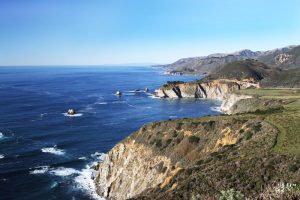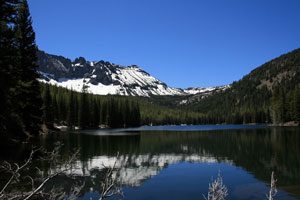
Paleo-Indians probably travelled along the Pacific coast of North America
First people in North America
Archaeologists call the time just after people first came to North America , about 20,000 BC, the Paleo-Indian period. During the Paleo-Indian period, all the people in North America were nomads and got their food by hunting and gathering, and especially by fishing. Some of these people stayed in Alaska and Canada. We call them the Athabascans or the Dene.
First Native Americans
History of fishing
Native Americans articles
South along the Pacific Coast
Other people gradually went south along the Pacific coast, looking for warmer weather, little by little. Most of them probably got most of their food by fishing, gathering shellfish, and hunting seals. By about 14,000 BC, this group split up into smaller groups all over the West Coast and the Southwest. Some of these groups reached Central America and then South America around that time.
South America articles

Strawberry Lake, in southern Oregon
Killing off big animals
A third group of Paleo-Indians headed east instead of going south. As the mammoth became extinct, these Paleo-Indians began to hunt bison instead. They used spears and atlatls to hunt.
What’s an atlatl?
More about bison
Eventually they reached the east coast of North America. By 12,500 BC, there were people living in Florida. Here there were still mammoths, but they didn’t last long. All up and down the East Coast, like other Stone Age people, the Native Americans ate a lot of fish and shellfish.
Speaking different languages
By the time Native Americans had covered the whole country, people in North America had developed different languages, and couldn’t understand each other talking anymore.
Native American language groups
The cold snap we call the Younger Dryas, which started about 11,000 BC and ended about 9,500 BC when warmer weather came back, created a good environment for Native Americans to live in, with plenty of variety.
New people reach South America
Then around 9000 BC, with the end of the Younger Dryas, another of these West Coast or Central American groups moved south into South America. They mostly replaced the people who had come first – maybe there was a war? or some sort of sickness? Nobody knows yet.
[…] also invented weaving in the Americas, maybe around the same time as in Afro-Eurasia. They might have brought band-weaving with them from […]